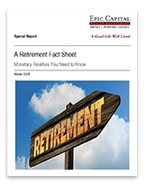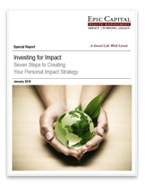Market Update – Three Implications of the Latest Inflation Release
Mar 15, 2023

- The monthly consumer inflation rate slowed slightly to 0.4% in February from 0.5% the previous month, enough to push the annual rate of inflation down to the lowest since mid-2021.
- Housing costs accounted for over 70% of the increase in February and were the largest contributor to the monthly growth rate. This component will not likely be a significant driver of inflation by year end as more multi-family units come to market.
- Headline annual inflation rose 6%, the smallest increase since September 2021 and should reassure investors that inflation will cool further in the coming months.
- Food inflation rose 0.3% in February, the smallest increase since April 2021. Food prices are convincingly on a downward trend for the past seven months.
- Bottom Line: Even amid current banking scares, the Federal Reserve (Fed) will still prioritize price stability over growth and likely hike rates by 0.25% at the upcoming meeting. Shelter costs are poised to ease as more multi-family units come online throughout the year—as the supply of housing units increase, prices will slow and potentially decline. Investors should expect inflation to improve in the latter half of this year and will likely be interested in taking on more market exposure in portfolios.
First, Fed Will Likely Focus on Price Stability Mandate Over Growth
Investors should expect the Federal Open Market Committee (FOMC) to focus on the inflation portion of the dual Congressional mandate for price stability and full employment, i.e., the growth component of the mandate. Although the markets are still interpreting the risks within the smaller, regional banking sector, as of now, the volatility is contained without major risks of contagion. Unlike the Great Financial Crisis, larger banks are currently well-capitalized and hedged against broader economic risks. Cash holdings at commercial banks are roughly 14% of total assets, 11 percentage points higher than at the beginning of the Great Financial Crisis. Cash on hand will buffer larger banks from some of the risks. Further, the Fed’s new lending facility, the Bank Term Funding Program, is able to provide additional funding for eligible institutions that desire more cash on hand.
A key question for investors is will the fragilities within Silicon Valley Bank spread into the broader banking sector? The answer? Not likely.
Second, Shelter Costs Set to Cool
Monthly shelter costs are accelerating, rising faster than 0.5% every month since January 2022. The annual inflation rate for rent alone is 8.8%, the highest since 1981 when Ronald Reagan was president. However, we do not think this trend will continue. Strong multi-family construction activity is clearly a good sign that rent costs will eventually ease. The growth in condo and apartment construction means the supply of multi-family units will increase this year as more projects come to market. New multi-family projects will likely dampen rents as more properties come online, so we should expect rent prices to decline this year as the supply of units grows. Industry data already shows declining rent prices, so it’s just a matter of time before the official government statistics reflect that easing. Investors and policy makers alike should expect a softening in housing-related inflation in the coming months.
Third, Food Gets Closer to Long-Term Trend
Decelerating food prices prove salve for consumers amid naggingly hot inflation. Food inflation rose 0.3% in February, the smallest monthly increase since April 2021. Grocery prices rose 0.25% in February, but restaurant prices (“Food consumed away from home”) reaccelerated to 0.63% month to month. Labor costs are a key component to restaurant prices, but for those lower income price-conscious consumers who want a good meal at home, chicken prices have outright declined for four out of the last five months.
What Does It Mean for You?
Inflation fighting is still the Fed’s main focus but the outlook for inflation the rest of the year looks promising. Further, the banking failure of Silicon Valley Bank seems to be contained and the general financial system appears stable. Although we expect another 0.25% increase in the Fed’s target rate at the upcoming meeting, the economy is weakening so conditions look like our baseline forecast this year will come to fruition. That is, the Fed pauses by the summertime, if not sooner, and the economy ekes out slightly positive growth for 2023. As inflation convincingly cools closer to the long-run target of 2%, investors will likely take on more risk for their portfolios.
IMPORTANT DISCLOSURES This material is for general information only and is not intended to provide specific advice or recommendations for any individual. There is no assurance that the views or strategies discussed are suitable for all investors. To determine which investment(s) may be appropriate for you, please consult your financial professional prior to investing. Investing involves risks including possible loss of principal. No investment strategy or risk management technique can guarantee return or eliminate risk in all market environments. For more information on the risks associated with the strategies and product types discussed please visit https://lplresearch.com/Risks References to markets, asset classes, and sectors are generally regarding the corresponding market index. Indexes are unmanaged statistical composites and cannot be invested into directly. Index performance is not indicative of the performance of any investment and do not reflect fees, expenses, or sales charges. All performance referenced is historical and is no guarantee of future results. Unless otherwise stated LPL Financial and the third party persons and firms mentioned are not affiliates of each other and make no representation with respect to each other. Any company names noted herein are for educational purposes only and not an indication of trading intent or a solicitation of their products or services. All information is believed to be from reliable sources; however, LPL Financial makes no representation as to its completeness or accuracy. Securities and advisory services offered through LPL Financial, a registered investment advisor and broker-dealer. Member FINRA/SIPC.
Tags: Current Events
More Insights
Few terms in personal finance are as important, or used as frequently, as “risk.” Nevertheless, few terms are as imprecisely defined. Generally, when financial advisors or the media talk about investment risk, their focus is on the historical price volatility of the asset or investment under discussion.
As Americans get their grills and beach chairs ready for the July 4th holiday, the stock market and the weather across much of the country have both been on heaters. Stocks and bonds continue to effectively navigate a complex policy landscape shaped by evolving trade dynamics, geopolitical tensions, and fiscal stimulus. The market’s resilience in … Continue reading “Market Update – America Gets Record High Stock Prices for Its Birthday”
Birthdays may seem less important as you grow older. They may not offer the impact of watershed moments such as getting a driver’s license at 16 and voting at 18. But beginning at age 50, there are several key birthdays that can affect your tax situation, health-care eligibility, and retirement benefits.
During times like these when geopolitical headlines can be unsettling for investors, we at LPL Research like to remind ourselves of one of our key investing principles. Markets have always faced challenges —ranging from geopolitical conflicts and economic downturns to natural disasters, political upheaval and health crises. These events often trigger short-term volatility and shake … Continue reading “Why Long Term Investing Beats Selling in Volatile Times”
Are you concerned about the inheritance taxes your heirs may have to pay? Then you may want to consider creating charitable lead trusts.
Services
Epic Capital provides the following comprehensive financial planning and investment management services: Learn More >



 Top of Page
Top of Page











